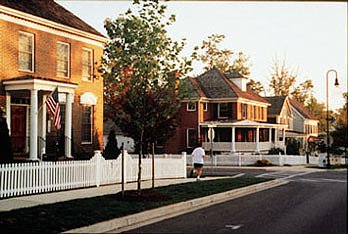|
~
The New Urbanism
~
|

The new Kentlands development in Gaithersburg, Maryland |
"The
New Urbanism is a reaction to sprawl. A
growing movement of architects, planners, and developers, the New Urbanism is
based on principles of planning and architecture that work together to create
human-scale, walkable communities.
"From
modest beginnings, the trend is beginning to have a substantial impact. More
than 600 new towns, villages, and neighborhoods are planned or under
construction in the US, using principles of the New Urbanism. Additionally,
hundreds of small-scale new urban infill projects are restoring the urban fabric
of cities and towns by reestablishing walkable streets and blocks."
(Robert Steuteville, New Urban News) |
"About once a week we receive a call from someone
who has read about one of the new towns we've designed, and is prepared
to move almost anywhere to experience the sense of community described.
Our first response is to ask the caller to consider one of the older
towns that has served as our inspiration. Frankly, as residents of
traditional communities ourselves, we wonder why someone would want to
live in a brand-new development rather than a neighborhood that has
matured over generations of use."
(Duany,
Plater-Zyberk, Speck, Suburban
Nation)
|
-
Overview: New Urbanism defined, plus the 13
principles of working neighborhoods from "New Urban News."
-
Smart Growth America:
Smart Growth America is a nationwide coalition promoting a better way to grow.
One that protects farmland and open space, revitalizes neighborhoods, keeps
housing affordable, and provides more transportation choices.
-
Virtual New Urbanist Neighborhood: Explore a virtual New Urbanist
Neighborhood at National Geographic.
-
The Transect: Developed by
Andres Duany and DPZ, the Transect is a categorization system that
organizes all elements of the urban environment on a scale from rural to
urban.
-
Slideshow: An online slideshow about New Urbanism.
-
Congress for the New Urbanism: the major professional organization.
-
Lexicon of the New Urbanism: Today, strip malls are called "town
squares," six-lane suburban arterials are called "parkways," and cookie-cutter
housing subdivisions are called "villages." Lexicon of the New Urbanism
is establishing a vocabulary and set of standards of urban form for planners,
developers and citizen activists to use in the creation of traditional
neighborhoods.
-
Divided We Sprawl.
A call for the reinvention of the American city and suburb that
would exploit the infrastructure of the one and mitigate the "frantic
privacy" of the other.
-
A Conservative Case
Against Suburbia. "If we step back and compare suburbs to the
ways people have lived for most of human history, we see that suburbia
is actually a fairly radical social experiment, and one directly linked
to many modern woes."
- Antidotes
to Sprawl Taking Many Forms. State and local
initiatives are currently supporting projects as varied as the
reconfiguring of a fishing village on Long Island, the conversion of an
1856 lock factory in a rundown section of Norwalk, Conn., into office
space and the transfer of development rights from tracts of privately
owned wilderness to parcels already zoned for construction.
-
New Urbanist Communities near Syracuse:
-
New Urbanist Communities around the country:
-
Ladysmith, Virginia. "A new community to live, work and play, where
traditional values and modern lifestyles find perfect harmony."
-
Middleton Hills, Wisconsin.
"Middleton Hills is a neighborhood for the present, designed with a sense for
the past."
-
I'On, South
Carolina. I'On is a Lowcountry village of remarkable
architectural and natural beauty, shimmering lakes and salty creeks, fine
eateries and offices you can walk to, and ample spaces to play. I'On is a
place to LIVE.
-
Mashpee Commons,
Massachusetts. "Mashpee Commons embodies traditional New England
style."
-
Amelia
Park, Florida. "If you've ever imagined what it would be like to
combine the community values of a traditional neighborhood with the modern
conveniences of the new millennium... well, here we are."
-
Glenwood Park, Atlanta.
"With a mix of pleasant tree-lined streets, city
houses, townhouses, apartments, stores, and parks, we are creating a lively
new city neighborhood two miles from the center of downtown Atlanta."
|

|
